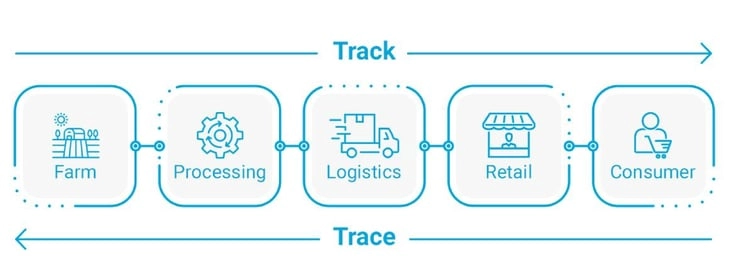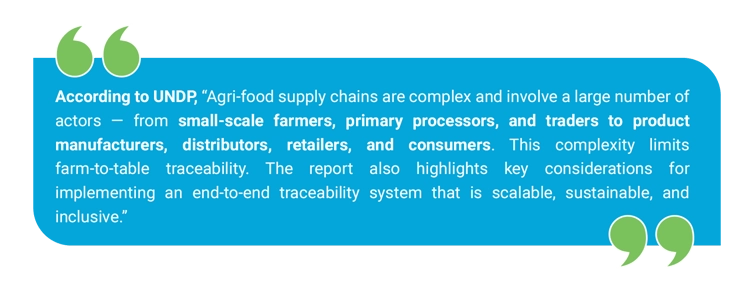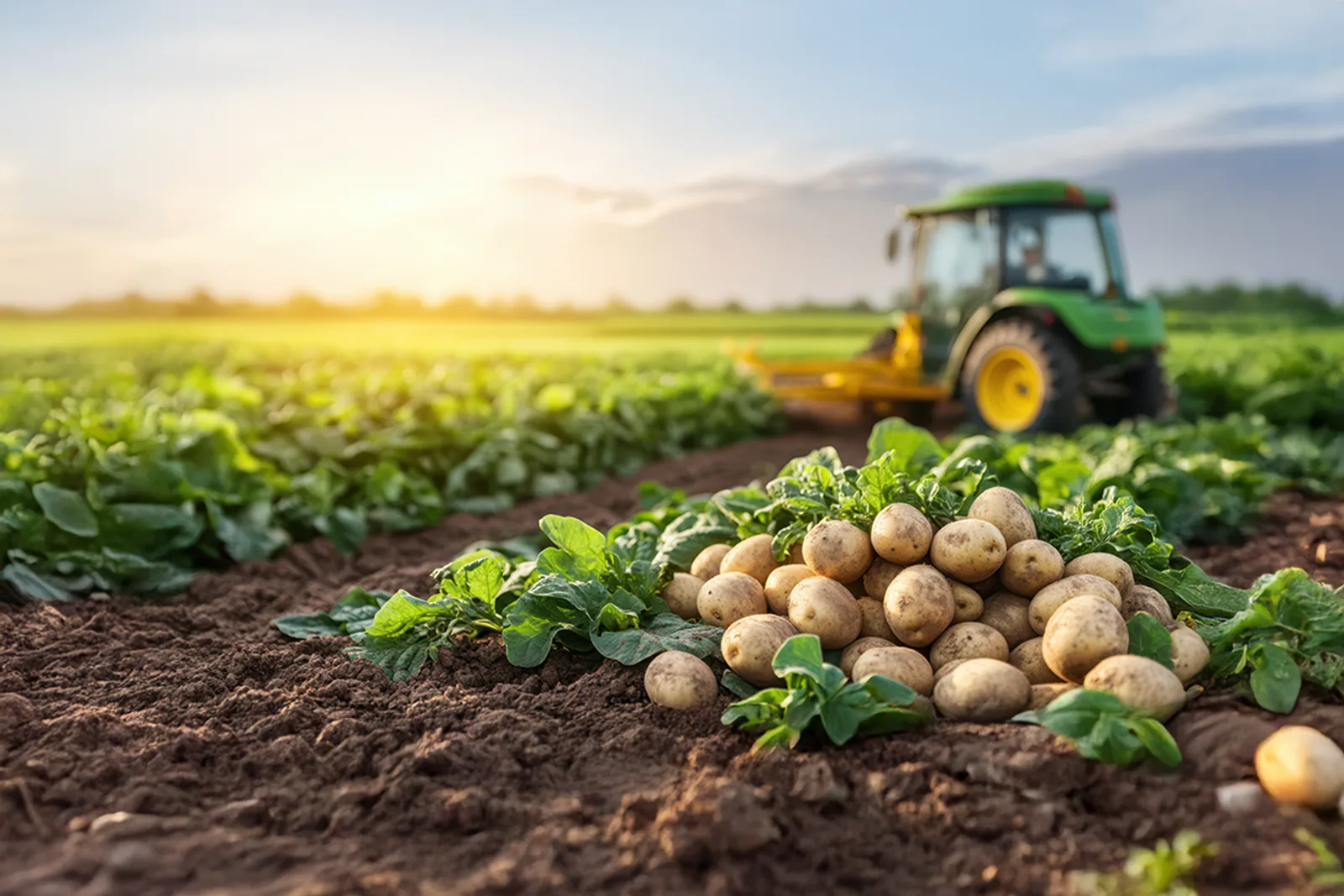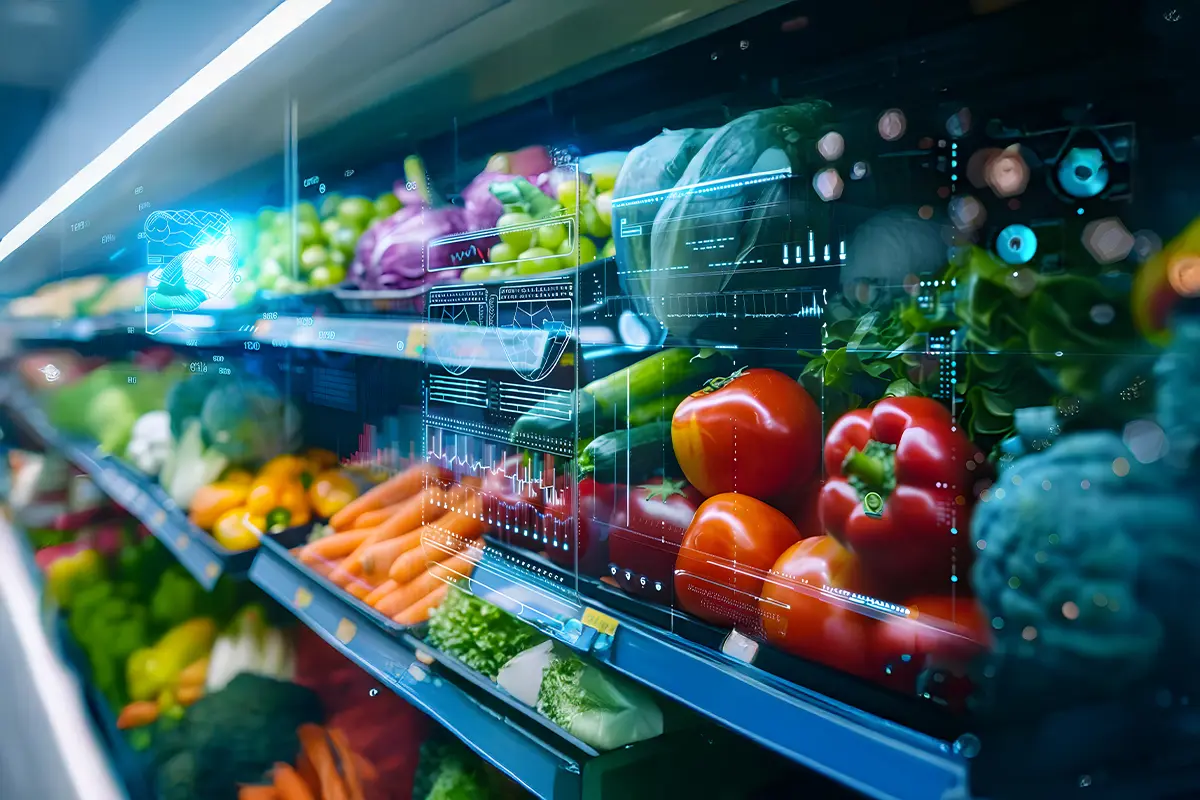- Ensuring overall food safety
- Reducing the danger of foodborne illnesses and contaminated food, which causes illness due to food poisoning in almost 1 in 10 people globally
- Lowering healthcare costs significantly as a staggering $110 billion per annum is wasted on productivity and medical expenses stemming from unsafe food, according to the WHO
- Building a secure and stable food supply chain ecosystem
These critical factors ultimately translate to a more robust economy, which is linked intricately to consumer confidence.
End-to-end data traceability – the nucleus of food safety
“Foodborne diseases impede socioeconomic development by straining healthcare systems and harming national economies, tourism, and trade.”
WHO
The globalization of supply chains, frequent foodborne diseases, and the emergence of informed consumers have put food safety under a global lens. This has made it critical for agri-output companies to ensure seed-to-shelf traceability. Here’s how farm-to-fork traceability can help prove fruitful for food processing companies:
Understanding the food origin/source:
The traceability information can help identify where the food comes from and where it goes – at every stage of the food supply chain process (from manufacturing to distribution) based on the predefined objectives of food inspection and certification.
Traceability includes critical elements such as:
- Origin of food source
- Processing history
- Distribution details
- Location of the food product within the supply chain
How it helps: Traceability brings about increased visibility and control of the food product among stakeholders in the farm-to-fork journey.
READ MORE- Farm-to-fork traceability for spice business
Moving with proactiveness:
When an untoward incident occurs, traceability aids all stakeholders in responding quickly. For example, if a product needs to be recalled in the interest of public health and safety, food traceability doubles as a superpower to proactively provide support in case of any eventuality.
How it helps: This increased transparency enables consumers to see how reliable the system is and goes a long way to preserve the credibility of the agri-output company. It also drives informed decision-making about costs and market reach while building consumer trust.
Promoting a culture of preventing food adulteration:
How it helps: The information gathered aids in the identification of areas for improvement and managing risks, making the process streamlined, profitable, and enhanced – every single time.
Need for transparency in the supply chain
The journey of farm produce from harvest to the consumer’s table is a multifaceted and complex one. The supply chain network must be seamlessly connected to ensure no time is lost in the process because it will lead to the wastage of perishables.
Globally, a 13.3% loss of food was witnessed at farm post-harvest, transport, wholesale, storage, and processing in 2020, while the food loss index stood at 98.7 in 2016 and 101.2 in 2020. Fruits, vegetables, and cereals are the most affected. Various challenges impede cold-chain adoption, ranging from the cost of power to limited financing options, although cold chains can considerably reduce wastage.
Another way to overcome the challenges of wastage is farm-to-fork traceability, which ensures efficient supply chain management. It also enables 100% transparency for consumers, paving the way to loyalty.

A shift in consumer behavior
Farm-to-fork traceability is vital for any brand to gain the trust of today’s informed consumers who seek info on:
- Location of production/the specific farm, farmers, etc.
- Stages in processing and products used therein
- Inputs used for growing such as feed, fertilizers, etc.
- Quantum of pathogens and pesticides used in production
- Quality checks at each stage of production
Importance of end-to-end food traceability
Traceability helps track the movement of food:

Food traceability enables the identification of sources for food contamination and fraud in the supply chain. This has unequivocal importance in food safety and helps to initiate a quick product recall, as it limits the scope to the affected batch only, which reduces loss. The absence of an efficient traceability system will have a devastating effect on the entire food ecosystem.
Components of food traceability
Food traceability comprises two components, namely:
Tracing (or upstream path) – Following the journey of farm produce from the source to the end user.
Tracking (or downstream path): Locates a farm product at a specific time in the production process, right from processing and distribution until it reaches the end consumer.

Technological innovations are a prerequisite to traceability
Farmer engagement is the key to ensuring traceability during the first stage of food production: farming. The use of technologies like GPS, remote sensing, satellite imagery, and blockchain, initiates the mapping of the supply chain.
The process starts with geotagging and farm digitization. This helps monitor farm practices that adhere to the package of practices (PoP) and provides insights into input usage. Agtech follows a systematic recording process that enables easy retrieval of this information as and when required. The digital record also acts as proof of Quality Compliance for exports and certifications.
Farm-to-fork strategy: traceability technologies that benefit consumers
According to the UNDP:

Understanding the role of technology to improve the farm-to-fork traceability journey

Tech disruption from seed-to-shelf with intelligent Agtech solutions
Modern agriculture is a culmination of intelligent Agtech tools, digital farming, and trustworthy farmers’ intuition and judgment. Cropin Trace is a 360-degree solution to bring end-to-end traceability across diverse farming processes. Using cutting-edge technologies such as AI, ML, and remote sensing, Cropin creates an intelligent, interconnected data platform, helping organizations digitize their operations from farm to fork.
Cropin, a full-stack Agtech platform, has partnered with over 250 organizations globally to digitize over 16 million acres of farmland and enrich the lives of about 7 million farmers.
The solution offered by Cropin captures real-time data on a single platform in immutable and decentralized ledgers to build a robust traceability system. This technology-supported traceability system integrates various stakeholders and helps companies adhere to quality compliance regulations, enhancing brand credibility and consumer confidence.
READ MORE- technology-supported honey-to-hive traceability
QR coding of the produce ensures anti-counterfeiting, manages traceability efficiently and maintains food integrity. The QR code provides product information at every stage of the product cycle and maintains a historical record of activities, which is accessible to the end consumer by a simple scan.
Cropin’s solution offers patented, tamper-proof QR codes that provide real-time visibility for supply chain transparency, increased operational efficiency, and end-to-end traceability.
The farm-to-fork traceability solution offered by Cropin ensures efficient supply chain management, curbs adulteration, and promises food safety and integrity.

Monitoring farmers to adhere to PoP

Giving advisory on harvest

Collecting produce from farm-gate and tracking it at the collection center

Tracing processing at food companies

Monitoring logistics as food reaches the distribution center and then retail shelves

Ensuring consumers enjoy safe food








